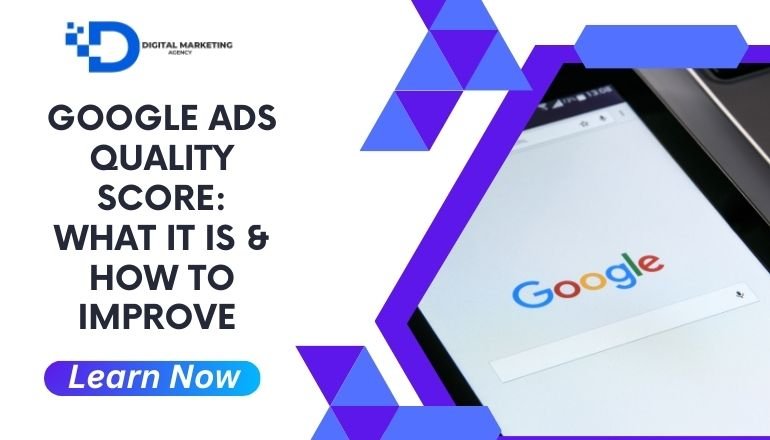In the competitive world of digital marketing strategies, Google Ads is a powerful tool for businesses looking to drive traffic, increase conversions, and boost brand visibility. However, not all ads are created equal some campaigns perform better than others, and one key factor in determining their success is the Google Ads Quality Score.
This score plays a pivotal role in how your ads perform and how much you pay per click. At Best Digital Marketing Agency, we specialize in optimizing PPC campaigns to ensure your business gets the most out of your Google Ads investment.
1. Introduction to Google Ads Quality Score
The Quality Score in Google Ads is a metric that determines the relevance and quality of your ads, keywords, and landing pages. It is a scale from 1 to 10, with 10 being the highest possible score. The higher your Quality Score, the less you pay per click and the more likely your ad will appear in top positions.
Google uses Quality Score to determine your ad rank, which ultimately impacts the visibility and performance of your ads. Improving your Quality Score is essential for maximizing the efficiency of your PPC Advertising efforts and driving better ROI-driven campaigns.
2. Why Google Ads Quality Score Matters
The significance of Quality Scores cannot be overstated in digital marketing. It impacts several important aspects of your Google Ads campaigns:
- Cost-Per-Click (CPC): A higher Quality Score can lower your cost per click, making your PPC campaigns more cost-effective.
- Ad Rank: Quality Score directly affects your ad rank. Ads with a higher Quality Score are more likely to be placed in prominent positions on the search engine results page (SERP), improving search engine visibility.
- Click-Through Rate (CTR): Google rewards ads with high relevance by placing them higher in search results. A higher CTR can lead to more traffic and ultimately better conversions.
- Better ROI: With a lower CPC and improved ad placement, you get more value for your advertising spend, leading to better ROI and more efficient lead generation.
3. Key Components of Google Ads Quality Score
Several factors contribute to determining your Quality Score. Understanding these components is crucial for improving your ad performance:
- Expected Click-Through Rate (CTR): This measures the likelihood that your ad will be clicked when shown. Ads with a higher CTR signal to Google that users find your ad relevant and engaging.
- Ad Relevance: Google evaluates how closely your ad copy matches the user’s search intent. Ads with highly relevant copy are more likely to receive a high Quality Score.
- Landing Page Experience: A smooth, relevant, and user-friendly landing page that aligns with the ad’s message is essential. A positive landing page experience improves conversion optimization.
- Historical Performance: Google considers how your account has performed historically, including the performance of past ads and campaigns.
4. Best Practices for Improving Google Ads Quality Score
Improving your Quality Score requires a strategic approach. Here are some actionable tips:
- Focus on Relevance: Ensure that your ad copy is closely aligned with the keywords you are targeting. Relevance is key to improving your ad rank and CTR.
- Create High-Quality Landing Pages: Your landing page should match the user’s search intent. Optimize the page for speed, mobile responsiveness, and clear calls-to-action (CTAs).
- Use Negative Keywords: Implementing negative keywords helps prevent your ads from being shown to irrelevant audiences, improving ad relevance and CTR.
- Test Ad Variations: Continuously test different versions of your ad copy (A/B testing) to identify which performs best. Use data-driven insights to refine your messaging.
- Optimize for Mobile: Ensure that your ads and landing pages are mobile-friendly, as a significant portion of users browse and shop on mobile devices.
5. Common Mistakes to Avoid in Google Ads
When aiming to improve your Quality Score, be mindful of these common pitfalls:
- Ignoring Landing Page Quality: A poor landing page experience can harm your Quality Score. Make sure your landing pages are relevant, fast, and optimized for conversions.
- Overlooking Mobile Optimization: Failing to optimize for mobile devices can hurt both your Quality Score and your ad performance.
- Not Reviewing Keyword Relevance: Using broad or irrelevant keywords in your campaigns can lead to low ad relevance, which negatively impacts your Quality Score.
- Skipping Ad Testing: Without testing multiple ad variations, you miss valuable insights that can improve your campaigns over time.
6. How Google Ads Quality Score Fits into a Comprehensive Digital Marketing Strategy
The Google Ads Quality Score plays a vital role in the overall success of your digital marketing campaigns. It works in tandem with SEO services, social media marketing, and content optimization to drive both short-term and long-term visibility. By optimizing your Quality Score, you lower your advertising costs and increase your ad visibility, which leads to more traffic, conversions, and ultimately better online branding.
Incorporating Quality Score optimization into your omnichannel strategy ensures that your PPC campaigns, Google Ads, and other digital marketing efforts are aligned for maximum efficiency and better user engagement.
Conclusion: Key Takeaways
In conclusion, the Google Ads Quality Score is a critical factor in determining the effectiveness and cost-efficiency of your PPC campaigns. By improving ad relevance, landing page experience, and CTR, you can boost your Quality Score, lower your CPC, and drive better ROI. Implement the best practices shared in this article to optimize your campaigns and avoid common mistakes that can hinder your success.
At Best Digital Marketing Agency, we specialize in creating ROI-driven campaigns that improve your Google Ads Quality Score and deliver measurable results. Ready to take your digital marketing strategy to the next level? Contact us today to get started!
SEO Keywords Used: Google Ads Quality Score, PPC advertising, digital marketing strategies, online visibility, ROI-driven campaigns, conversion optimization, audience targeting, Google Ads campaigns, landing page experience, mobile-first design, SEO services, ad relevance, and ad rank.













